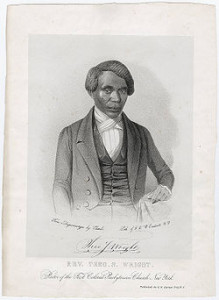Theodore S. Wright (1797-1847) was an African-American abolitionist and minister who was active in New York City, where he led the First Colored Presbyterian Church as its second pastor. He was the first African American to attend Princeton Theological Seminary (and any United States theological seminary), from which he graduated in 1829. In 1833 he was a founding member of the American Anti-Slavery Society, and served on its executive committee until 1840.
Theodore Sedgwick Wright was born about 1797 to free parents. He is believed to have moved into New York City with his family, where he attended the African Free School.[1] With the aid of Governor DeWitt Clinton and Arthur Tappan of the New York Manumission Society, and men from Princeton Theological Seminary, Wright was aided in his studies at the graduate seminary. In 1829 he was the first African American to graduate from there, and the first to complete theological studies at a seminary in the United States.
Before 1833, Wright was called as the second minister of New York’s First Colored Presbyterian Church and served there the rest of his life. (It was later known as Shiloh Presbyterian Church and is now St. James Presbyterian Church in Harlem.) He followed the founder, Samuel Cornish.
In 1833 Wright was a founding member of the American Anti-Slavery Society, which had an interracial membership and leadership. He served on the executive committee until 1840. That year he left with other moderate members, including Arthur and Lewis Tappan, and helped found the American and Foreign Anti-Slavery Society. They disagreed with some of William Lloyd Garrison’s proposals, including his insistence on having women in leadership positions and opposition to organized religion.
In 1837, at a national Colored Convention, Wright opposed a resolution advocating black self-defense as “un-Christian.” Wright supported activities of other black communities in the state; for instance, in 1837 he spoke at the dedication of the First Free Church of Schenectady, the first black church in the city.
For years Wright acted as a conductor for the Underground Railroad in New York and used his house at 235 W. Broadway as a station. He served on New York’s Committee of Vigilance, established to try to help fugitive slaves evade slave catchers and resist their being returned to the South.
